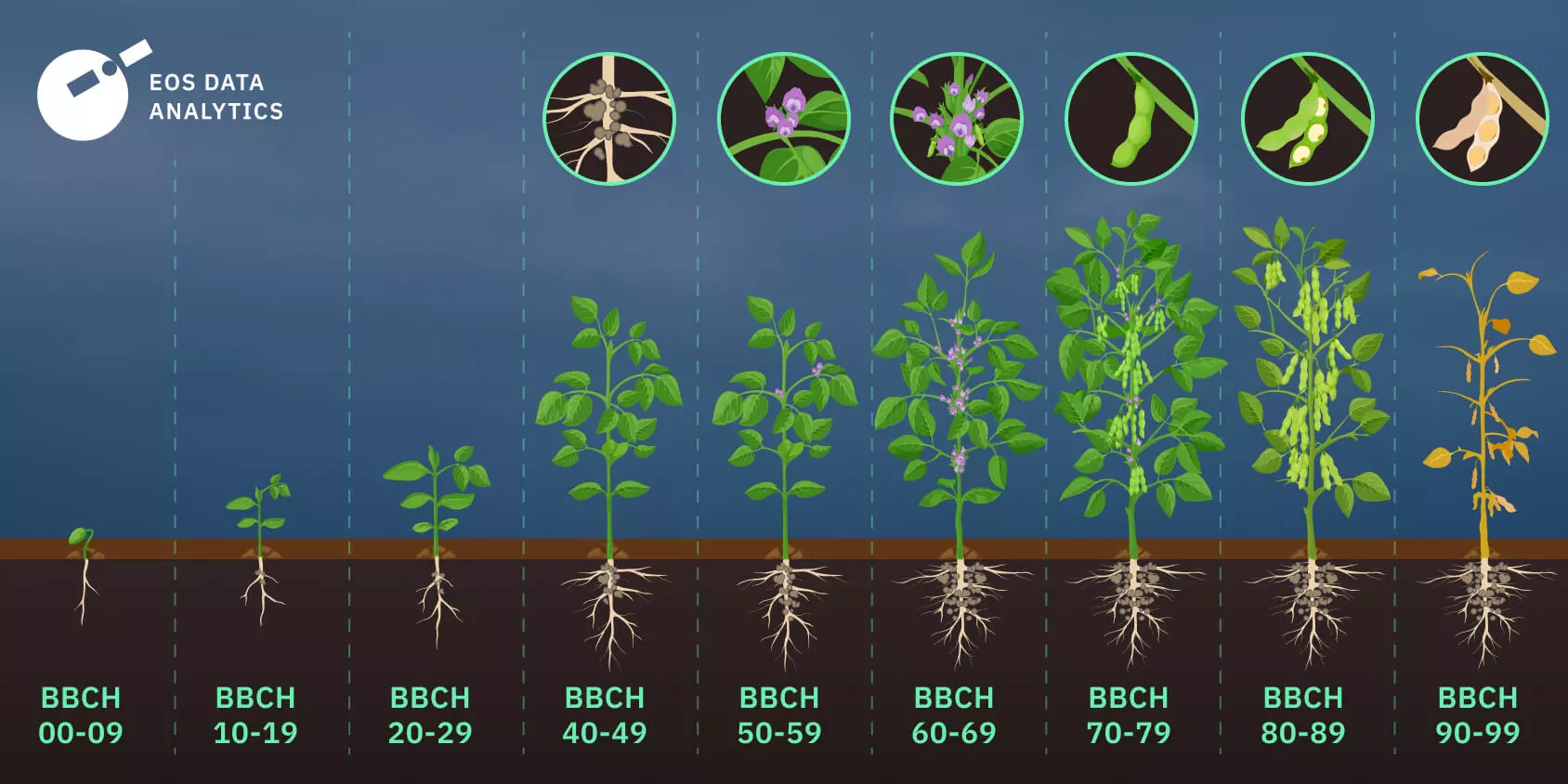
The recommendations provided in this article serve as general guidelines. Particular cultivation requirements may vary based on the unique conditions of each field and the selected hybrids.
Soybean Growth Stages: Season-Long Guide For Crop Care
Throughout their life cycle, soybeans go through different growth stages, and each one has its unique requirements for optimal crop health and productivity. To maximize crop yields, farmers must be aware of when and how to apply crop maintenance based on the distinct vegetative and reproductive stages of soybeans. From germination to ripening and senescence, this soybean growth stage guide covers it all. You will find out the underlying plant processes and advice on how to manage the crop in terms of watering, drainage, nutrient management, and disease control at each stage.
Soybean Growth Stages In The BBCH Scale
There may be overlapping stages of growth in your field. When half or more of the soybean plants in the field achieve or surpass a specific stage, we say that the crop has entered a new growth stage. Keep in mind that the side shoot formation doesn’t necessarily begin after BBCH 19. In this scenario, proceed directly to the principal soybean growth stage 2 (Tillering).
Soybean plant growth stages according to BBCH scale
BBCH 00–09: Germination
This growth stage begins when a soybean seed has soaked up about half of its weight in water. Root hairs and lateral roots, the plant’s primary access points to water and nutrients, start to form at soybean germination stage. Soybeans emerge from the ground in 10–18 days, though this can vary depending on soil moisture and temperature, crop variety, and planting depth.
Sow seeds at a depth of 1–1.5 inches (2.5–3.8 cm). Planting depths below 2 inches (5 cm) may reduce seed viability and stand density due to the longer path the seeds must take to germinate. Seed vaccination with Bradyrhizobium japonicum bacteria can improve plant nitrogen fixation if fields haven’t been planted with soybeans for more than two years.
Later in this growth stage, around 7–10 days, the cotyledons fulfill the plant’s nutrient demands. Loss of a single cotyledon at this soybean growth stage doesn’t affect plant growth and development rate. However, yields can drop by 10% if both cotyledons are lost during the emergence stage or shortly thereafter.
The seed germination rate is your priority at this growth stage. The Association of Official Seed Certifying Agencies (AOSCA) has established a minimum germination threshold of 80% for certified soybean seed . Factors like good seeds, well-prepared seedbeds, appropriate sowing technique, application of micronutrients, and an optimum climate for growth can increase the rate at which seeds germinate.
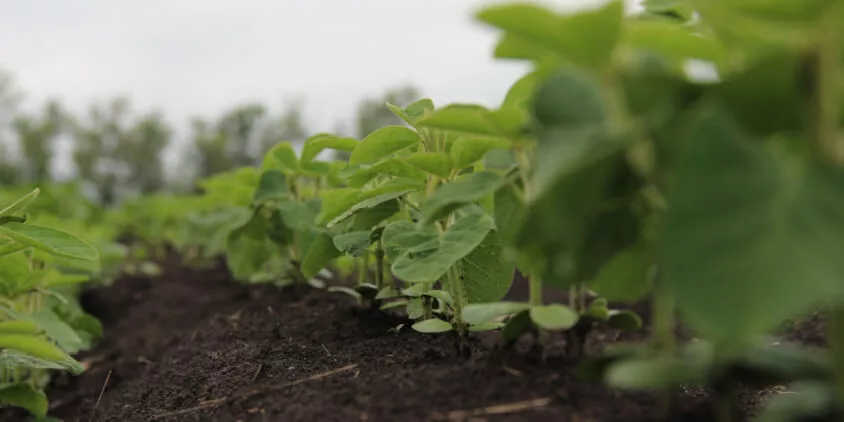
BBCH 10-19: Leaf Development (Main Shoot)
Not long after the emergence stage of growth, the green cotyledons open, letting the developing leaves draw on stored energy and absorb some sunlight. After the soybean cotyledon stage, the unifoliolate leaves unfold first. The next leaves to uncurl have three leaflets each and are called trifoliolate.
Fertilizing Young Soybeans
The application of nitrogen (N) at different stages of soybean growth varies a lot. Soybeans can satisfy up to 60% of their nitrogen requirements on their own throughout most growth stages. However, nitrogen fixation starts three to four weeks after seeds are sown. This is why seedlings require N-fertilization, particularly in long, cold springs.
In the early growth stages, when the soybean root system is not fully developed, foliar fertilization with microelement mixes is crucial for ensuring future harvests. Among the many trace elements, boron (B), molybdenum (Mo), magnesium (Mg), zinc (Zn), and copper (Cu) rank highest in significance.
Pest Monitoring And Control
After mild winters that result in above-average bean leaf beetle (BLB) survival rates, the pest decreases soybean plant populations, particularly in fields planted early. However, first-generation BLBs that feed on soybean leaves at this growth stage rarely diminish leaf area to the level of economic significance.
Meanwhile, the beetle can spread many viruses, dangerous at the current stage of soybean growth and beyond, including the bean pod mottle (BPMV), southern bean mosaic (SBMV), cowpea chlorotic mottle (CCMV), and cowpea mosaic. BPMV can lower yields by 10–15% or more when combined with other viruses. Seed treatment or foliar-applied pyrethroid insecticides between BBCH 09 and BBCH 12 growth stages help lower the incidence of bean pod mottle. This presumably prevents the early populations of pests from harming seedlings at the soybean leaf development stage. To further reduce viral incidence, it may be beneficial to spray pyrethroid insecticide around the flowering stage of soybean growth.
Because soybeans are more vulnerable to illnesses and insect infestations in their early stages of growth they require frequent scouting. At times of high pest populations, young plants, especially the first-sown and first-emerged, are at a higher risk of damage. Yield loss is imminent if beetle control methods are not used during this period.
Although direct observation remains essential for accurately identifying BLBs during the soybean leaf development stage, our cutting-edge EOSDA Crop Monitoring platform offers a powerful Disease risk function that streamlines the process. By leveraging this technology, you can eliminate excessive checks and focus your scouting efforts solely on areas where they are truly necessary. Also, we provide you with a 14-day disease forecast to ensure you are not caught off guard and can take preventive measures.

To top it all off, the MSAVI index allows you to monitor the vegetation status throughout the early stages of crop growth. The index map can be used for defining problem areas to scout, thus empowering you to make informed and timely decisions.
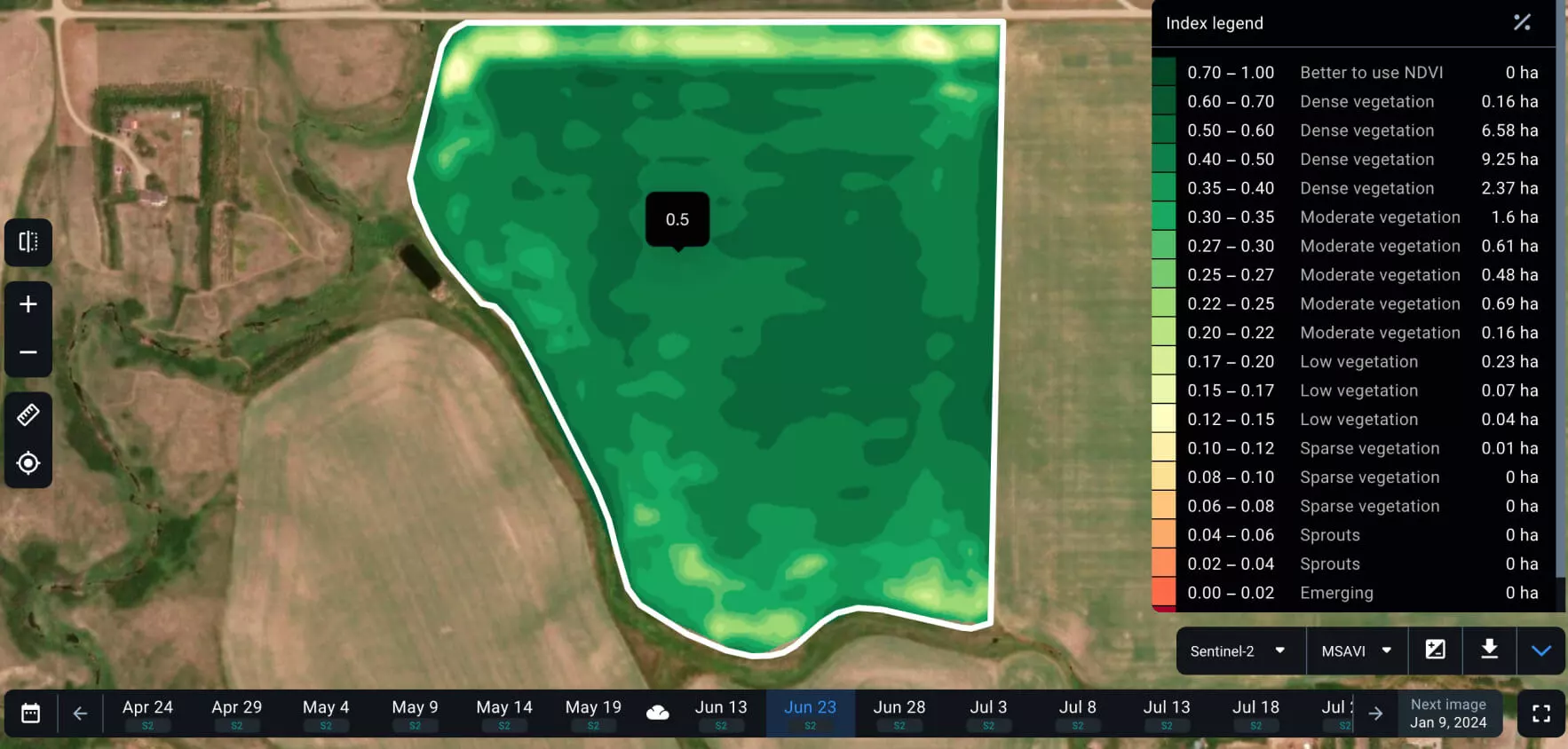
Hail Damage Assessment
Although young soybean plants may not withstand even modest leaf damage without a major drop in yield, plants in their later growth stages may handle heavy leaf loss without suffering a noticeable yield decline. It usually takes a few days after an incident before damage assessments can be done. Consider dubious soybean plants as one-half when making your calculations.
After you’ve calculated the stand’s survival rate, it’s time to estimate the potential yield. Plants can make up for reduced stands in the case of damage at soybean vegetative growth stages. To get a ballpark idea of your harvests from a damaged stand, consider the table below.
Potential yields in reduced soybean stands
| Plants per acre (thousands) | Plants per hectare (thousands) | Yield optimum, % |
|---|---|---|
| 180 | 73 | 100 |
| 140 | 57 | 100 |
| 120 | 49 | 99 |
| 100 | 40 | 94 |
| 80 | 32 | 86 |
| 60 | 24 | 76 |
| 40 | 16 | 64 |
| 20 | 8 | 46 |
If the present stand’s condition is uncertain, replanting is an option. Soybeans are light-dependent; thus, latitude affects how long it takes for plants to go from seed to flowering stage of growth. Soybean crops can produce 80% of their maximum yield if planted no later than June 20 in the majority of growth regions.
Make sure your crops have enough time to undergo critical growth stages by leveraging weather records in EOSDA Crop Monitoring. Recognizing local weather patterns will allow you to assess if the amount of light, heat, and rainfall that the soybeans receive before the flowering stage is sufficient for a bountiful crop.
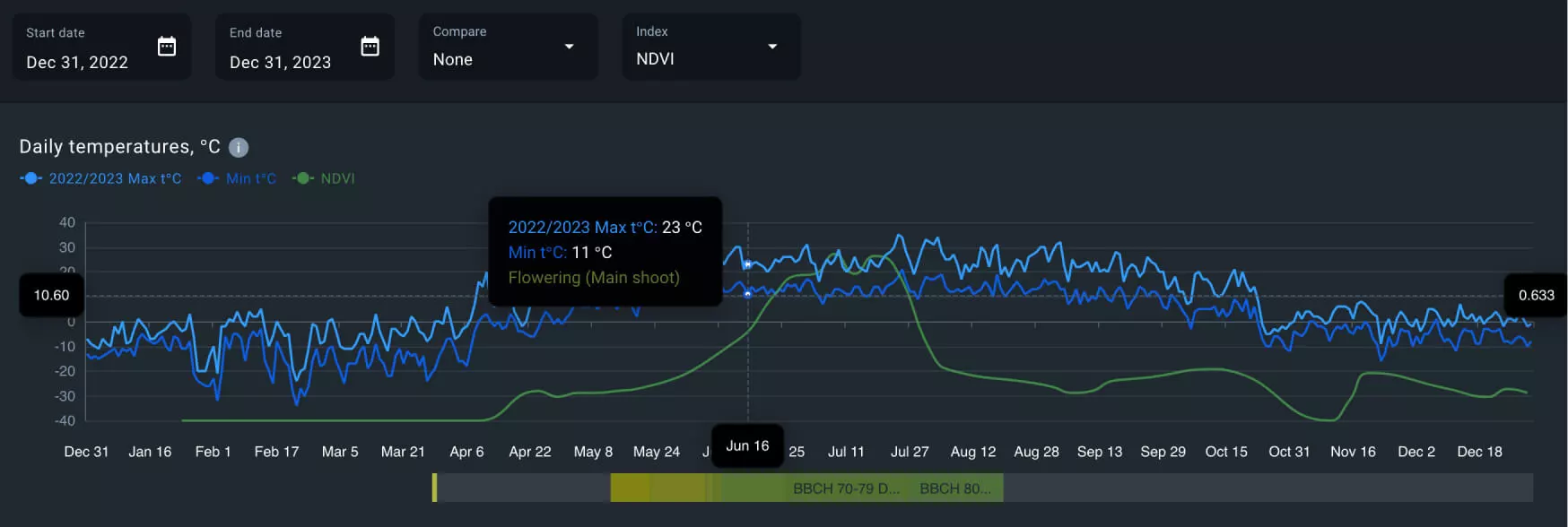
EOSDA Crop Monitoring
Manage your fields with high-resolution satellite images for the most accurate and timely changes detection!
BBCH 20-29: Formation Of Side Shoots
During this stage of soybean growth and development, the mother axis of the immature inflorescence differentiates. A new axis forms at the space between the stem and the leaf as the shoots subsequently branch in the leaf axil. The main shoot (leading bud) takes up the majority of nutrients, which means that the growth of lateral shoots (axillary buds) is not as quick. An indeterminate soybean plant’s ability to recuperate from stress or injury is enhanced by the growth of side shoots at this stage.
Meeting Soybean Nutrient Requirements
Sufficient nutrient stocks ensure the normal growth of all plant parts throughout the intense development stages, which start with the growth of side shoots and go on until the flowering stage. Boron can be applied to promote branching in growth areas where this trace element is not easily accessible to soybeans. But fertilizing with nitrogen is superfluous because the plant is already fixing it from the air at this growth stage.
Pests And Diseases To Scout For
Several diseases, including iron chlorosis and soybean rust, as well as pests such as soybean aphids and cyst nematodes, are economically significant at this soybean growth stage. Let’s view these issues and remedies for them in more detail.
Important diseases and pests at the stage of soybean lateral shoot growth and ways to control them
| Pests and diseases | Causes and favorable conditions | Effects on plants | Control measures |
|---|---|---|---|
| Iron chlorosis |
|
|
|
| Soybean rust |
|
|
|
| Soybean aphids |
|
|
|
| Soybean cyst nematode (SCN) |
|
|
|
Rather than attempting to fix these problems after they have already arisen, it will be far more beneficial to stop them in their tracks. Using the EOSDA Crop Monitoring’s Disease Risk tool, you can estimate risks that these issues will arise in your soybean field and then dispatch scouts to investigate.
BBCH 40-49: Development Of Harvestable Vegetative Plant Parts
At this soybean crop growth stage, flowers develop in inflorescence, bud-protecting sepals are set up, productive stems develop actively, and anthers (microsporogenesis) and stigmas (megasporogenesis) form. It’s a stage of all plant organs’ growth in length. Ovules and pollen grains (female and male reproductive cells, respectively) are produced now.
Water And Nutrient Requirements
You can increase the number of blooms in an inflorescence and promote their growth by using nitrogen- and phosphorus-based fertilizers at this development stage. The soybean root system coordinates the growth to meet the increased demand for water and nutrients caused by the aerial section’s expansion. Given that both the root and the shoot rely on each other for specific nutrients, an adequate supply and movement of these nutrients are critical at the current growth stage of soybeans. More precise regulation of plant growth can be achieved by providing small amounts of specific nutrients.
Humidity And Soil Moisture Considerations
At this growth stage, keep an eye on the air humidity and make sure the soil stays at the right moisture level for soybean growth. Good drainage is also required if the field is prone to waterlogging. Otherwise, the following crop diseases could develop at this soybean phenological stage:
- Frogeye leaf spot (FLS) thrives in warm, humid areas with regular rainfall. Susceptible varieties may suffer crop losses of up to 30%. So it’s necessary to plant disease-resistant soybean varieties, rotate crops, use tillage, and spray fungicide in the most severe cases.
- Stem canker growth is likely in wet conditions. To control canker, choose tolerant soybean varieties and don’t plant too early, especially in damp environments. Reduce the risk of canker overwintering by rotating your crops.
- Phytophthora may arise on any soil waterlogged for a long time, although it tends to occur on poorly drained soils. Manure, potash, or sewage sludge applied in large quantities just before planting soybeans could make diseases worse. Seed treatment, resistant variety planting, better field drainage, and, if feasible, remediating soil compaction, are the primary control strategies.
The weather and soil moisture data readily available in EOSDA Crop Monitoring lend a helping hand in preventing disease outbreaks at the current stage of soybean development. Through the platform, you can assess and improve the situation without having to physically visit the field.
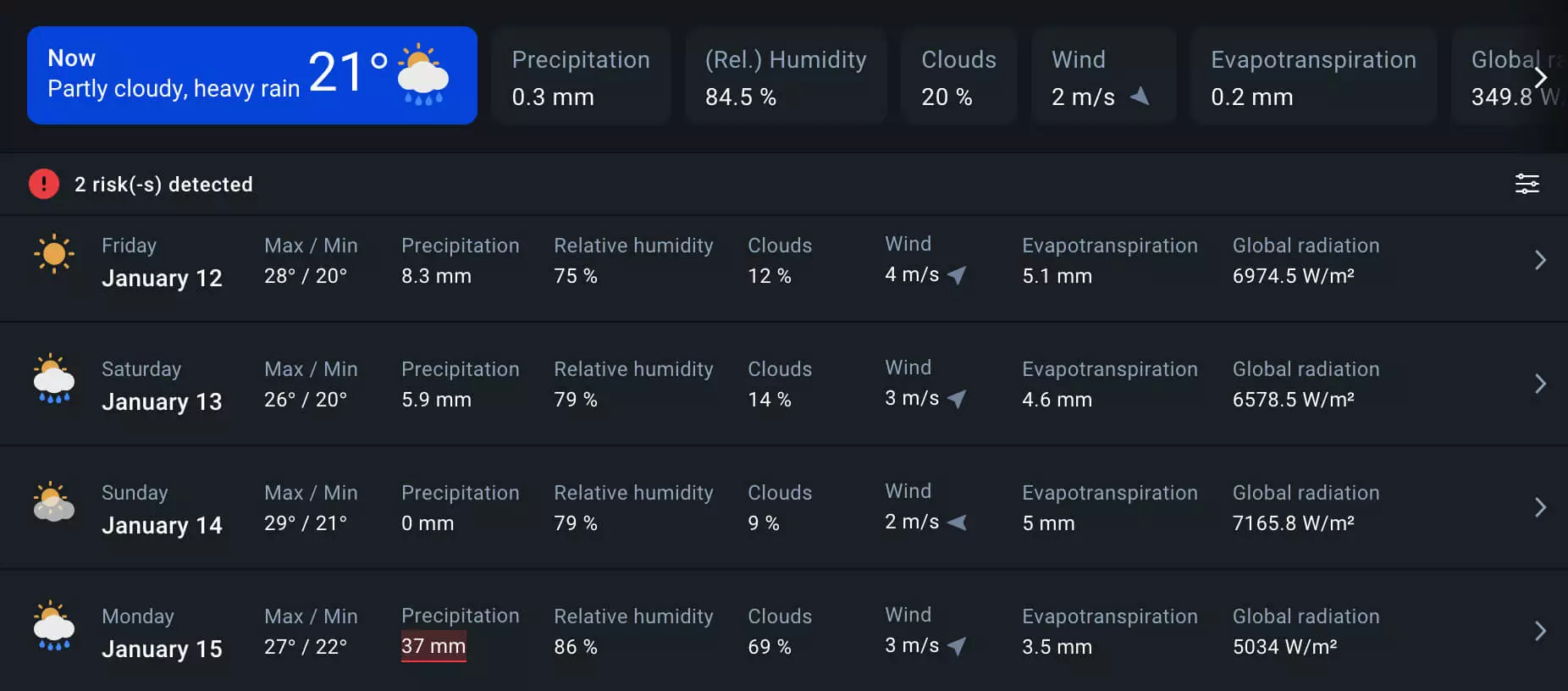
Dectes stem borers can also damage soybeans at this growth stage. No-till fields where the overwintering larvae’ environment remains undisturbed and growth regions experiencing warmer-than-average winters are particularly at risk. The resulting loss of yield can be anywhere from 7 to 12%.
Because of their potential as larval hosts, weeds like cocklebur (xanthium) and giant ragweed must be eradicated. Insecticide applications made before egg-laying are most effective at controlling the young larvae’ growth. Soybean growth areas scheduled for late harvesting should get an insecticide application because of the increased risk of lodging.
BBCH 50-59: Inflorescence Emergence (Main Shoot)
All of the inflorescence’s organs have reached their last stages of growth and development at this point. Still, there is more growth at the biggest upper internode. Soybean crops experience their peak symbiotic activity between the blooming and budding growth stages.
To encourage yields, you need to fertilize soybeans with nitrogen at the current growth stage. Fertilizers containing boron are also ideal for use at the soybean inflorescence development stage since they promote pollination and the growth of reproductive organs. Boron, applied during this growth stage, makes plants more resistant to soil salinity and drought. Lime and potassium fertilizers, when used excessively, exacerbate boron deficiency in soybeans; thus, apply them cautiously.
BBCH 60-69: Flowering (Main Shoot)
This is the first of the soybean reproductive stages. Typically, there will be more blooms at each node than the plant can fill. Rather than producing viable pods, many of them will abort as stresses arise during the next two weeks. When soybeans are in the midst of the blooming stage, they are vulnerable to heat/cold stress and the spread of pests and diseases.
The growth of two-spotted spider mites accelerates during the soybean full flowering stage when there are prolonged periods of drought and heat waves. If this weather persists, insect management will be critical to preventing economic yield losses. To effectively control the growth of pest populations, spray the soybean canopy with pyrethroid solutions at high pressure.
White mold thrives in damp, cool growth conditions. An estimated 2–5 bushels per acre (0.1–0.3 tons per hectare) loss in yield occurs for every 10% rise in white mold instances . The best way to control its growth is to incorporate diverse cultural practices: variety selection, rotating crops, controlling weeds, no-till, and, if needed, reducing the establishment of dense canopies.
Exposure to extreme temperatures during the soybean flowering stage might compromise soybean fertility. Use EOSDA Crop Monitoring to keep an eye on how soybeans are doing in the face of heat or cold stress. You can set a desired temperature threshold and receive prompt notifications whenever the temperature surpasses or falls below that point.

BBCH 70-79: Development Of Fruits And Seeds
The soybean pod filling stage determines the final seed yield. Root system activity declines when nutrients begin to flow from leaves to seeds. By prolonging the life of the photosynthetic components and biomass buildup, foliar fertilization at this growth stage helps increase yields and improve seed quality.
The soybean plant is in its most vulnerable state at this growth stage because it must relocate nutrients from leaves and roots, which weakens it and makes it more susceptible to foliar and root diseases. A little bit of a purple tint to the seed coat could indicate a soybean infection with the bean pod mottle virus. The resulting yield losses can range from 3 to 52%, depending on the hybrid as well as contamination timing and severity .
At this stage of soybean growth watch for bean leaf beetles, as they eat the pods and thus degrade seed quality and reduce yield. You should be ready for a rapid growth of beetle densities. So, send scouts to inspect the soybean fields for pest infestation every 5 to 7 days. At economically significant population densities, pesticide use is crucial. Keep an eye on your soybeans with the NDRE index map; it becomes most useful towards the end of the growing season and can help you avoid major losses.
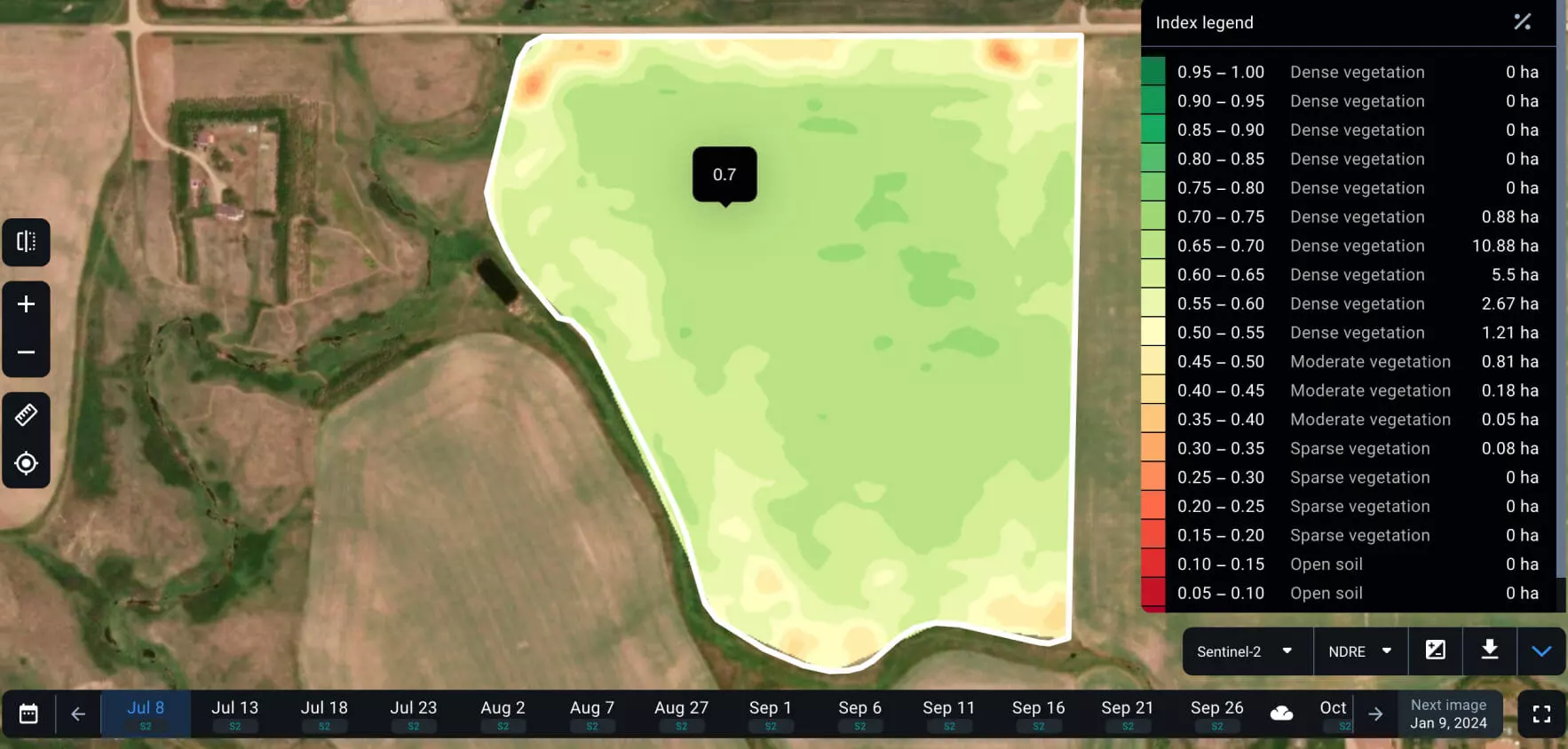
BBCH 80-89: Ripening Of Fruits And Seeds
The seed reaches its maximum dry matter content at this growth stage of soybeans. The beans and pods go from green to a yellowish hue. Stress during the maturity stage is less likely to diminish yield than it has been during any other growth stage.
Managing Fields Damaged By Fall Flooding
The most common problems that can occur in soybeans in the event of a fall flood are lodging, shattering, and poor grain quality. Each of these issues can reduce yield. If your crops are flooded at the ripening soybean crop stage, you need to check them carefully to see how bad the damage is. Harvest soybean growth areas with different extents of damage separately, badly damaged areas early and slightly affected areas later.
Preventing Freeze Damage To Plants
When exposed to freezing temperatures for short periods, as is common during early frosts, soybeans show high tolerance. Having said that, leaves can be damaged by temperatures below 32°F (0°C), while pods and beans can be damaged by prolonged exposure to temperatures below 30°F (-1°C). The extent of damage varies depending on the soybean growth stage, the lowest temperature, and the time of exposure.
Keep tabs on the local weather forecasts in EOSDA Crop Monitoring to make sure your crop stays safe at the ripening stage. Knowing when frosts are likely in the next two weeks, you may schedule soybean harvest accordingly and prevent severe crop damage.

Proper Harvest Timing
It is recommended to harvest soybeans once they reach a moisture content of 13–14%. Upon achieving the stage of physiological maturity, soybeans have a grain moisture content of more than 50%; however, under dry conditions, this moisture content drops to a harvestable 13% in just 2 weeks. Plants’ full growth shows up in 95% of the pods in their mature hue. After this stage, harvest in five to ten days, given the right drying conditions. Plants may keep their leaves for longer if they are subjected to environmental stress during this soybean growth stage; therefore, it’s important to start checking seed moisture levels before the leaves fall completely.
Throughout this development stage, soybeans are prone to shattering after experiencing a few cycles of being wet and dried. Thus, harvesting delays cause economic losses due to shattering and lower bean quality.
Harvesting Freeze-Damaged Soybeans
Harvesting soybeans at ideal soil moisture levels isn’t always possible because of early frost. After sufficient defoliation, soybeans can be harvested even at 18% moisture or somewhat higher, but they will require extra drying. You might also need to adjust the combine settings to minimize yield losses in frozen soybeans. Reducing the concave-to-cylinder clearance and increasing the rotor or cylinder speed can provide a stronger threshing action for wet soybeans.
BBCH 90-99: Senescence
At the current soybean development stage, all plant parts left after harvesting undergo senescence. Although soybeans don’t leave much residue behind, their hydrophobic nature can make it difficult for water to seep into the soil or evaporate from beneath the residue in the spring. On the other hand, soybeans are known for their nitrogen contributions and ability to increase crop yields when planted in rotation. Thus, removing soybean residue could negatively impact N availability in the soil.
Some of the common tillage practices after harvesting soybeans include:
- deep tillage or discing;
- no-till;
- low-disturbance vertical tillage;
- high-disturbance vertical tillage.
Each soybean farm has its specific needs for post-harvest residue management and tillage. It is essential to find a happy medium between economic considerations, soil health concerns, and the needs of the following crop growth.
About the author:
Vasyl Cherlinka is a Doctor of Biosciences specializing in pedology (soil science), with 30 years of experience in the field. He attended the engineering college in Ukraine and received his degree in agrochemistry, agronomy and soil science in the Chernivtsi National University. Since 2018, Dr. Cherlinka has been advising EOSDA on problems in soil science, agronomy, and agrochemistry.